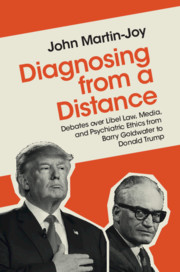 Diagnosing from a Distance
Diagnosing from a Distance Book contents
- Diagnosing from a Distance
- Diagnosing from a Distance
- Copyright page
- Dedication
- Contents
- About the Author
- Acknowledgments
- Abbreviations
- Introduction An Ethical Dilemma
- Chapter 1 Psychoanalysis, Media, and Politics from the Rise of Hitler to the 1950s
- Part I Diagnosis from a Distance and Libel Law in the 1960s: Goldwater v. Ginzburg
- Part II Professionalization and the Rise of the Goldwater Rule
- Chapter 5 “To Protect Public Figures”
- Chapter 6 The CIA and the White House
- Chapter 7 Furor
- Conclusion On History, Ethics, and Pluralism
- Appendix The Goldwater Rule in 1973 and Today
- Photographs of Key People and Events
- Notes
- Works Cited
- Index
Chapter 5 - “To Protect Public Figures”
The APA and the Goldwater Rule
from Part II - Professionalization and the Rise of the Goldwater Rule
Published online by Cambridge University Press: 29 February 2020
- Diagnosing from a Distance
- Diagnosing from a Distance
- Copyright page
- Dedication
- Contents
- About the Author
- Acknowledgments
- Abbreviations
- Introduction An Ethical Dilemma
- Chapter 1 Psychoanalysis, Media, and Politics from the Rise of Hitler to the 1950s
- Part I Diagnosis from a Distance and Libel Law in the 1960s: Goldwater v. Ginzburg
- Part II Professionalization and the Rise of the Goldwater Rule
- Chapter 5 “To Protect Public Figures”
- Chapter 6 The CIA and the White House
- Chapter 7 Furor
- Conclusion On History, Ethics, and Pluralism
- Appendix The Goldwater Rule in 1973 and Today
- Photographs of Key People and Events
- Notes
- Works Cited
- Index
Summary
In the 1960s and 1970s, consensus was growing about the need for professionalism and ethical standards in medicine and psychiatry. Using the APA’s archives, I show that the Fact episode of 1964 concerned the APA greatly. Not only did the APA write to Ginzburg and object to his special Fact issue on Goldwater, but it followed Ginburg’s subsequent career closely. The group adopted the Goldwater Rule in 1973 in order to prevent episodes like the Fact debacle. After the Rule’s adoption, disagreements over it emerged within the APA. Members wrote in apparent confusion to the APA Ethics Committee, seeking guidance on how the Rule applied to their work. The APA never contemplated applying the Rule to forensic psychiatry, to the work of psychiatrists in insurance companies, or to the practice of psychological profiling for the FBI and CIA. It was comment in the media, and the risk of damage to psychiatry’s public image, that concerned the APA. The result was the appearance of a double standard: individual psychiatrists are banned from commenting on public figures, while psychiatrists working for organizations and government agencies may comment without interview or consent.
Keywords
- Type
- Chapter
- Information
- Diagnosing from a DistanceDebates over Libel Law, Media, and Psychiatric Ethics from Barry Goldwater to Donald Trump, pp. 137 - 171Publisher: Cambridge University PressPrint publication year: 2020
